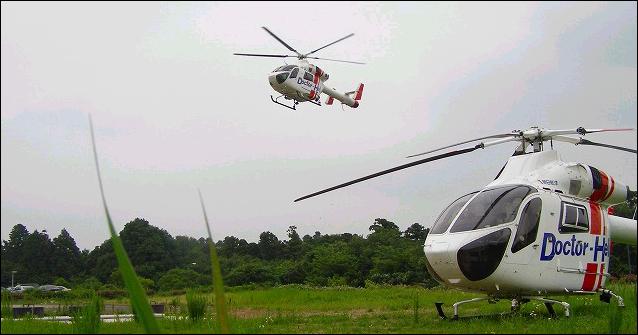
<Straight Up>
If no HEMS
System is Available


Eleven Doctor-Helicopter
programs are now operating, with three more programs expected to go
into service this year. In 2006, these eleven Doctor-Helicopters
provided medical care to 4,197 patients, an average of one patient
per day for each of the eleven programs. What would have happened to
these patients if there were no Doctor-Helicopters?

Prior to the start of
full-fledged helicopter emergency medical service (HEMS) in Japan, a
one-year trial program was conducted each at two university hospitals
from October 1999 to determine the effectiveness of HEMS. The chart
below shows results of the trial operations. Please note that each of
the two helicopters carried a doctor and nurse for each rescue
mission.
Doctor-Helicopter
Trial Operations Results
(October 1999-Sept. 2000, N = 466)
The number of
patients attended to by the two helicopters during the trial
operation was 446. The above chart indicates that 70 patients died
who were picked up by helicopter, compared to 116 deaths from
non-helicopter ambulance pick-ups. Similarly, 203 patients rescued by
helicopter eventually returned to work, compared to the only 98
patients rescued by non-helicopter ambulances. From this we can
gather that rescuing patients by helicopter leads to nearly double
the number of patients who fully recover.

It is, however, necessary
to conduct long-term research on individual patients' levels of
recovery to determine more exact results, as there is the risk of
inaccurate data if only short-term and vague definitions of recovery
are used. As such, patient recovery research was again done in 2003,
after full-fledged Doctor-Helicopter operations were in place. This
data is shown below.
2003
Doctor-Helicopter Service Operations Results
(N = 1,592)
|
|
Returned to
work
|
Aftereffects
|
Deaths
|
|
Mild/moderate
|
Severe
|
|
1,592 patients recovered by
HEMS
|
872
|
246
|
111
|
363
|
|
*1,592 patients recovered by
ambulance
|
603
|
290
|
203
|
496
|
* Estimated numbers of
patients with various types of medical emergencies on the assumption
that the patients were transported by ambulance.
Seven Doctor-Helicopters
programs were in place during 2003, providing 1,592 patients with
medical care. Of these, 363 died. It is estimated that 496 patients
would have died if the Doctor-Helicopter services were not available
and ground ambulances were used. In other words, 133 patients were
saved thanks to the Doctor-Helicopter, from which we can extrapolate
that 27 percent of the 496 deceased ground-ambulance patients could
have been saved by helicopter.
By the same token, the
number of patients with aftereffects dropped, thanks to the
Doctor-Helicopter service. Also, the number of patients with severe
aftereffects, including those in a persistent vegetative state,
decreased by 45 percent, leaving 872 patients able to return to work.
The numbers of patients who could have returned to work who were
attended to by ground ambulance services is estimated at 603.
Though the patient recovery
rate from 2003 HEMS operations is not as promising as that of the
HEMS trial operations, the results are still very positive,
particularly knowing that data from the 2003 HEMS operations is more
robust.

The majority of people in
Japan admit that helicopter ambulances save more lives than ground
ambulances, but it is difficult to actually quantify how much more
effective helicopters are for saving lives. At this time, there are
no conclusive studies on determining the exact differences between
ground and helicopter ambulance patient recovery rates, though
experts from many countries have tried to flesh out these
differences. We do know, however, that the patient recovery studies
done in Japan persuasively show the effectiveness of HEMS, in
comparison to ground ambulance service.
(W. Nishikawa /
translated by Y.Yamano,
printed in Japan Aviation Weekly of August 13, 2007)

上の英文は、日本航空新聞社の週刊英字紙に掲載されたものである。山野豊氏に翻訳していただいた。もともと外国向けの記事なので、日本ではよく知られた内容だが、念のために要旨は下の通りである。

ドクターヘリなかりせば
日本では現在11ヵ所でドクターヘリが飛んでいる。今年中には3ヵ所増えて14ヵ所になる予定である。11ヵ所のヘリコプターで救護された患者さんは、昨2006年の実績が4,197人だった。平均すれば11機のヘリコプターが毎日1人ずつ救護したことになる。
しかし、もしもドクターヘリがなかったら、これらの人びとはどうなっただろうか。その観点から、ドクターヘリが本格的に飛び始める前、1999年10月から1年間2ヵ所の大学病院で試験運航が行なわれた。それぞれに救急装備をしたヘリコプターを置き、ドクターとナースが乗って救護活動をした結果、下表のような成果が得られた。
表1 ドクターヘリの効果(1999年10月〜2000年9月、N=466)
|
|
社会復帰
|
中軽度後遺症
|
重度後遺症
|
死亡
|
|
ドクターヘリ治療実績
|
203
|
140
|
53
|
70
|
|
救急車搬送推定
|
98
|
140
|
112
|
116
|
上表によれば、2機のヘリコプターによる1年間の救護患者数は466人。うち死亡は70人だったが、もしもヘリコプターがなくて救急車だけで搬送したとすれば死者は116人に上ったと推定される。すなわち46人がヘリコプターのお陰で生還したわけで、救命率は丁度40%となる。また社会復帰をした人は203人だったが、ヘリコプターがなければ98人しか復帰できなかったと推定される。つまり2倍以上の全快復帰である。

しかし、こうした推定作業にあたっては個々の患者について、長期間にわたり詳しく病状を調べる必要があり、厳密な判定が要求される。その点、どうしても曖昧さが残り、判定が甘くなるかもしれない。そうしたことを勘案しながら、ドクターヘリが本格活動に入ったのち、2003年にもう一度同様の調査がなされた。結果は表2のとおりである。
表2 ドクターヘリの効果(2003年、N=1592)
|
|
社会復帰
|
中軽度後遺症
|
重度後遺症
|
死亡
|
|
ドクターヘリ治療実績
|
872
|
246
|
111
|
363
|
|
救急車搬送推定
|
603
|
290
|
203
|
496
|
このときは7ヵ所の病院でドクターヘリが飛んでおり、1年間に1,592人の患者さんが救護された。そのうち亡くなった人は363人だが、もしもドクターヘリ・システムが存在せず、救急車だけで搬送されたとすれば496人が亡くなったと推定される。つまり133人がヘリコプターによって生還できたわけで、死亡者の削減は27%になる。
同様に、後遺症の残った人もそれぞれに減少し、植物状態を含む重度後遺症は45%減って、ほぼ半分となった。さらに社会復帰のできた人は872人だった。ドクターヘリがなければ603人にとどまったと推定されるので、復帰者は1.4倍を超えたことになる。
先の試行段階よりはきびしい推定結果だが、それだけ信憑性は高まったということができよう。

ヘリコプターの救命効果が救急車よりも高いことは多くの人が認めるところである。しかし、どれほど高いか。科学的に証明し、明確な数字で示すのはむずかしい。そのため多くの国々でさまざまな方法が試みられているが、いまだ確定的は方法が見つかっていない。上の日本の方法は多少の曖昧さが残るものの、多くの人の理解を得やすく、説得力もあるのではないだろうか。

(西川 渉、2007.8.21)
 (表紙へ戻る)
(表紙へ戻る)


